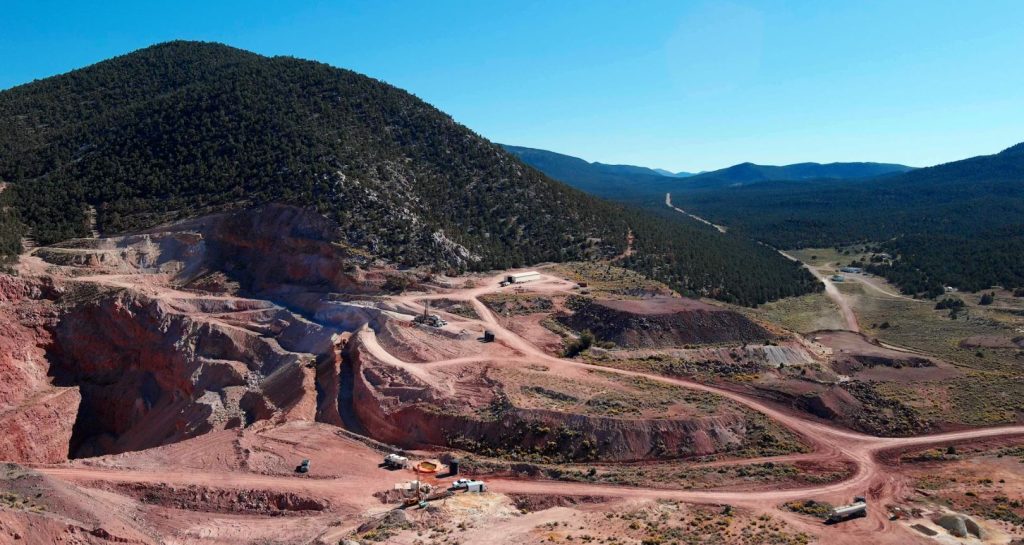Nevada King Gold drills 2.18 g/t gold over 93.6 metres at Atlanta mine, Nevada

Nevada King Gold Corp. [NKG-TSXV; NKGFF-OTCQX] reported assay results from six reverse circulation (RC) holes and one core hole recently completed at its Atlanta gold mine project located 264 km northeast of Las Vegas, Nevada in the prolific Battle Mountain trend. These holes plotted along section 22-7N were drilled across the high-grade feeder zone associated with several strands of a braided network of structures comprising the Atlanta mine fault zone (AMFZ).
Highlights included drill hole AT22HG-3T that returned 93.6 metres of 2.18 g/t gold and 17.1 g/t silver (bottomed in mineralization), including 61.0 metres of 1.31 g/t gold and 0.16 g/t silver and 32.6 metres of 3.83 g/t gold and 48.7 g/t silver, including 5.0 metres of 10.94 g/t gold 33.2 g/t silver.
AT22NS-54 returned 45.7 metres of 4.21 g/t gold and 79.6 g/t silver, including 25.9 metres of 5.40 g/t gold and 113.8 g/t silver. AT22NS-73 returned 80.8 metres of 2.31 g/t gold and 47.4 g/t silver.
Holes released today tie into two parallel drill sections previously released: section 22-6N 27.5 metres to the south and section 22-8N 27.5 m to the north. Good continuity in geology and gold-silver mineralization is seen between all three sections, with higher grade mineralization occurring between the East Atlanta and Atlanta King Faults and on both sides of the West Atlanta fault.
Section 22-7N demonstrates an east-west width of contiguous mineralization that exceeds 300 metres. This includes the 100-metre-wide, higher-grade AMFZ, as well as over 200 metres of lower-grade mineralization extending westward from the West Atlanta fault, where mineralization remains open to depth and to the west.
Shallow oxide mineralization present in AT22NS-73 (80.8 metres of 2.31 g/t gold and 47.4 g/t silver starting at 22.9 metres) is typical of the thicker, higher-grade mineralization encountered along the 30-metre-wide, wedge-shaped block occurring between the East Atlanta and Atlanta King faults. Nevada King is currently drilling along strike of this fault block to better define this near surface, high-grade Au-Ag zone.
Mineralization in hole AT22NS-54 (45.7 m of 4.21 g/t Au and 79.6 g/t Ag starting at 171 m) is typical of thicker, higher-grade mineralization seen in down-dropped blocks along the West Atlanta fault. Immediately west of AT22NS-54 are two historical holes that tested an adjacent fault block, returning 45 m at 5.24 g/t Au and 40.7 g/t Ag in AR-21 and 48.8 m at 3.95 g/t Au and 46.9 g/t Ag in 88-13. Taken together, both fault blocks are about 50 metres wide and strike parallel to the West Atlanta fault. The company is currently drill-defining this important structural corridor along strike with the objective of expanding tonnage and grade within a relatively shallow part of the resource zone.
The broad expanse of deep, lower grade mineralization hosted within variably silicified volcanics and underlying silicified breccia occurring west of the West Atlanta fault starts at depths of 150 m to 250 m and typically extends to depths of 300 m to 400 m, although many of Nevada King’s holes and historical holes bottomed in mineralization, so the lower depth constraint is uncertain. Core hole AT22HG-3T and RC hole AT22HG-4, drilled west of the West Atlanta fault, intercepted 93.6 m averaging 2.18 g/t Au and 17.1 g/t Ag and 41.2 m grading 1.92 g/t Au and 22.7 g/t Ag, respectively.
Cal Herron, exploration manager of Nevada King, stated: “The four southern-most drill sections (sections 22-5N, -6N, -7N and -8N) across the AMFZ show strong correlation of geology and mineralization between the sections, allowing further refinement to our geologic model for the gold and silver mineralization at Atlanta, (see geologic model discussion section below). A primary focus of the 2023 drilling program is defining and following structures responsible for localizing higher-grades. As we’ve already seen, this requires closely spaced holes in order to tie together the fault blocks and wedges hosting high grades along the AMFZ. Nevada King’s new geologic model now gives us a blue print for targeting higher-grade Au-Ag mineralization to add to the Atlanta resource model. To this end, one rig is currently engaged in definition drilling along the AMFZ and a second drill will soon be added. At the same time, defining the thick mineralization seen west of the West Atlanta fault provides significant blue sky potential at Atlanta, where mineralization remains open to depth and to the west. As such, the company has dedicated one drill for this area in order to vectorize the mineralization and expedite our evaluation process.”
Nevada King is the third largest mineral claim holder in Nevada, behind Nevada Gold Mines (Barrick/Newmont) and Kinross Gold. District-scale projects in Nevada King’s portfolio include the 100%-owned Atlanta mine, located 100 km southeast of Ely, the Lewis and Horse Mountain-Mill Creek projects, both located between Nevada Gold Mines’ large Phoenix and Pipeline mines, and the Iron Point project 35 km east of Winnemucca, Nevada.
The company is well financed, with cash of approximately $9.3-million as of February, 2023.
The Atlanta mine is a historical gold-silver producer with an NI-43-101-compliant, pit-constrained resource of 460,000 ounces gold in the measured and indicated category (11 million tonnes at 1.3 g/t) plus an inferred resource of 142,000 ounces gold (5.3 million tonnes at 0.83 g/t).
